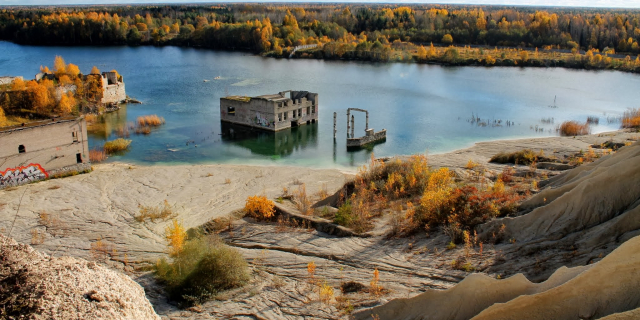Tallinn () is the capital and most populous city of Estonia. Situated on a bay in north Estonia, on the shore of the Gulf of Finland of the Baltic Sea, Tallinn has a population of about 461,000 (as of 2024) and administratively lies in the Harju maakond (county). Tallinn is the main governmental, financial, industrial, and cultural centre of Estonia. It is located 187 km (116 mi) northwest of the country's second largest city, Tartu; however, only 80 km (50 mi) south of Helsinki, Finland, also 320 km (200 mi) west of Saint Petersburg, Russia, 300 km (190 mi) north of Riga, Latvia, and 380 km (240 mi) east of Stockholm, Sweden. From the 13th century until the first half of the 20th century, Tallinn was known in most of the world by variants of its other historical name Reval.
Tallinn received Lübeck city rights in 1248; however, the earliest evidence of human population in the area dates back nearly 5,000 years. Th...Read more
Tallinn () is the capital and most populous city of Estonia. Situated on a bay in north Estonia, on the shore of the Gulf of Finland of the Baltic Sea, Tallinn has a population of about 461,000 (as of 2024) and administratively lies in the Harju maakond (county). Tallinn is the main governmental, financial, industrial, and cultural centre of Estonia. It is located 187 km (116 mi) northwest of the country's second largest city, Tartu; however, only 80 km (50 mi) south of Helsinki, Finland, also 320 km (200 mi) west of Saint Petersburg, Russia, 300 km (190 mi) north of Riga, Latvia, and 380 km (240 mi) east of Stockholm, Sweden. From the 13th century until the first half of the 20th century, Tallinn was known in most of the world by variants of its other historical name Reval.
Tallinn received Lübeck city rights in 1248; however, the earliest evidence of human population in the area dates back nearly 5,000 years. The medieval indigenous population of what is now Tallinn and north Estonia was one of the last "pagan" civilisations in Europe to adopt Christianity following the Papal-sanctioned Livonian Crusade in the 13th century. The first recorded claim over the place was laid by Denmark after a successful raid in 1219 led by King Valdemar II, followed by a period of alternating Scandinavian and Teutonic rulers. Due to the strategic location by the sea, its medieval port became a significant trade hub, especially in the 14–16th centuries, when Tallinn grew in importance as the northernmost member city of the Hanseatic League. Tallinn Old Town is one of the best-preserved medieval cities in Europe and is listed as a UNESCO World Heritage Site.
Tallinn has the highest number of startup companies per person among all capitals and larger cities in Europe and is the birthplace of many international high-technology companies, including Skype and Wise. The city is home to the headquarters of the European Union's IT agency, and to the NATO Cyber Defence Centre of Excellence. In 2007, Tallinn was listed among the top-10 digital cities in the world, and in 2022, Tallinn was listed among the top-10 "medium-sized European cities of the future".
The first archaeological traces of a small hunter-fisherman community's presence[1] in what is now Tallinn's city centre are about 5,000 years old. The comb ceramic pottery found on the site dates to about 3000 BCE and corded ware pottery to around 2500 BCE.[2]
 The lesser coat of arms of Tallinn depicts the Dannebrog cross.
The lesser coat of arms of Tallinn depicts the Dannebrog cross.Around 1050 AD, a fortress was built in what is now central Tallinn, on the hill of Toompea.[3]
As an important port on a major trade route between Novgorod and western Europe, it became a target for the expansion of the Teutonic Knights and the Kingdom of Denmark during the period of Northern Crusades in the beginning of the 13th century when Christianity was forcibly imposed on the local population. Danish rule of Tallinn and northern Estonia started in 1219.
 Toompea castle
Toompea castleIn 1285, Tallinn, then known more widely as Reval, became the northernmost member of the Hanseatic League – a mercantile and military alliance of German-dominated cities in Northern Europe. The king of Denmark sold Reval along with other land possessions in northern Estonia to the Teutonic Knights in 1346. Reval was arguably the most significant medieval port in the Gulf of Finland.[4] Reval enjoyed a strategic position at the crossroads of trade between the rest of western Europe and Novgorod and Muscovy in the east. The city, with a population of about 8,000, was very well fortified with city walls and 66 defence towers.
A weather vane, the figure of an old warrior called Old Thomas, was put on top of the spire of the Tallinn Town Hall in 1530. Old Thomas later became a popular symbol of the city.
In the early years of the Protestant Reformation, the city converted to Lutheranism. In 1561, Reval (Tallinn) became a dominion of Sweden.
During the 1700–1721 Great Northern War, plague-stricken Tallinn along with Swedish Estonia and Livonia capitulated to Tsardom of Russia (Muscovy) in 1710, but the local self-government institutions (Magistracy of Reval and Estonian Knighthood) retained their cultural and economical autonomy within Imperial Russia as the Governorate of Estonia. The Magistracy of Reval was abolished in 1889. The 19th century brought industrialisation of the city and the port kept its importance.
 Harju Street in Tallinn old town after the Soviet aerial bombing in March 1944
Harju Street in Tallinn old town after the Soviet aerial bombing in March 1944On 24 February 1918, the Estonian Declaration of Independence was proclaimed in Tallinn. It was followed by Imperial German occupation until the end of World War I in November 1918, after which Tallinn became the capital of independent Estonia. During World War II, Estonia was first occupied by the Soviet army and annexed into the USSR in the summer of 1940, then occupied by Nazi Germany from 1941 to 1944. During the German occupation Tallinn suffered from many instances of aerial bombing by the Soviet air force. During the most destructive Soviet bombing raid on 9–10 March 1944, over a thousand incendiary bombs were dropped on the town, causing widespread fires, killing 757 people, and leaving over 20,000 residents of Tallinn without shelter. After the German retreat in September 1944, the city was occupied again by the Soviet Union.
During the 1980 Summer Olympics, the sailing (then known as yachting) events were held at Pirita, north-east of central Tallinn. Many buildings, such as the Tallinn TV Tower, "Olümpia" hotel, the new Main Post Office building, and the Regatta Centre, were built for the Olympics.
In 1991, the independent democratic Estonian nation was restored and a period of quick development as a modern European capital ensued. Tallinn became the capital of a de facto independent country once again on 20 August 1991. The Old Town became a World Heritage Site in 1997,[5] and the city hosted the 2002 Eurovision Song Contest.[6] Tallinn was the 2011 European Capital of Culture, and is the recipient of the 2023 European Green Capital Award.[7] The city has pledged to cut greenhouse gas emissions by 40% by 2030 and takes pride in its biodiversity and high air quality.[8][9] But critics say that the award was received on false promises since it won the title with its "15-minute city" concept, according to which key facilities and services should be accessible within a 15-minute walk or bike ride but the concept was left out of the green capital program and other parts of the 12 million euro program amount to a collection of temporary and one-off projects without any structural and lasting changes.[10]


































Add new comment